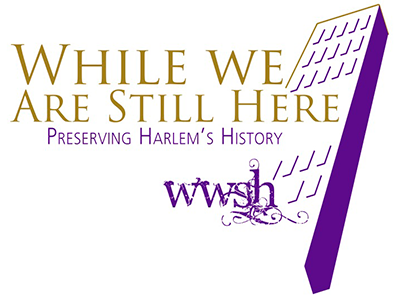Documentary
Racing against the dynamic forces of gentrification and time, the documentary, "In the Face of What We Remember: Oral Histories of 409 and 555 Edgecombe Avenue," captured the extraordinary history of two Harlem buildings that were, perhaps, the social, political, and cultural epicenter of the Black World.
We premiered the film at Columbia University's Miller Theater, in 2018.
Partial List of Current and Previous Residents 409
Pura Belpre, Folklorist; Librarian
Julius Bledsoe, Vocalist
William Stanley Brathwaite, Poet, Literary Critic, Editor
Katherine Butler-Jones, Educator; Playwright; Author
Eunice Carter, First African-American Woman District Attorney, New York City
Elizabeth Catlett, Visual Artist
May Edward Chinn, MD, First African American Woman Graduate, Bellevue Hospital Medical School; Pianist for Paul Robeson
Marvel Cooke, Assistant to Du Bois; Journalist; National Legal Defense Secretary, Angela Davis Defense Committee
Shirley Graham Du Bois, Musicologist; Playwright; Activist
Safiya Henderson-Holmes, Activist; Poet
James Weldon Johnson, Novelist; Playwright; Lyricist; National Secretary, NAACP, U.S. Ambassador
Jimmy Lunceford, Musician; Bandleader
Louise Thompson-Patterson, Organizer of Vanguard, a literary salon; Activist; Co-director Langston Hughes's Suitcase Theater
William Patterson, Attorney; Activist
Norman Skinner, NCAA Basketball Record Holder
Stephanie St. Clair, Numbers Racket Genius, Dutch Schultz’s Arch Nemesis
Maudelle Bass Weston, Dancer, Artist-Model for Diego Rivera, Mark Rothko, and others
Clarence Cameron White, Composer; Violinist
Walter White, NAACP National Secretary
Roy Wilkins, NAACP National Secretary
Bruce Wright, Jurist
Partial List of Current and Previous Residents 555
Jane Bolin, NAACP Board Member; First African-American Female Judge in the U.S.
Ann Brown, First Bess, in "Porgy and Bess," and muse for the Gershwin brothers
Bessie Allison Buchannan, Dancer; Singer; First African-American Assemblywoman in N.Y.S.
Daddy Grace, Minister; Owner of 555 Edgecombe Avenue
Drs. Kenneth and Mamie Clark, Research Psychologists
Coleman Hawkins, Musician
Jack Geiger, MD Founder, Physicians for Social Responsibility
Johnnie Hodges, Musician
Clarence L. Holte, Bibliophile; Advertising Executive
Tulani Kinard, Vocalist with Sweet Honey in the Rock
Andy Kirk, Musician; Bandleader
Canada Lee, Actor; Activist
Joe Louis, World Heavy-weight Champion
Alphonso Mizell and Larry Mizell, Music Producers
Rose Morgan, Beauty Culture Entrepreneur
Snub Mosley, Musician
Eslanda Goode Robeson, Anthropologist; Chemist; Activist
Billy Rowe, New Columnist for Amsterdam News, Pittsburgh Courier, and others
Gil Scott-Heron, Bluesologist, Musician, Poet
Cassandra Wilson, Vocalist
The "Capital of the Black World"
We are filmmakers, activists, historians, writers, and professors, who are passionate about sharing the myriad history of Black America. In the Face of What We Remember: Oral Histories of 409 and 555 Edgecombe Avenue is one piece of that long, complex, beautiful story.
In the case of In the Face of What We Remember: Oral Histories of 409 and 555 Edgecombe Avenue we chronicle the tale of two buildings, primarily through the voices of the elders who live there. We decided that we could not sit by and watch the powerful narrative of these dwellings vanish.
One of the elders of 409 fondly remembers her neighbors—Thurgood Marshall and W.E.B. Du Bois— saying that when Marshall saw her on her way to music lessons, he insisted on carrying her cello for her. She says that Du Bois was a tad formal and aloof. Another shares his reminiscence of seeing Sugar Ray Robinson when he went to visit Joe Louis at 555. Yet another shares her fascination over Johnny Hodges's daughter's pet monkey named Baby, who always sat upon her owner's shoulder.
And, there is so much more: In addition to many other celebrated individuals and those below the "public radar," the entire early Black leadership of the National Association for Colored People (NAACP) lived at 409. They were James Weldon Johnson, Du Bois, Walter White, and Roy Wilkins. What other places in New York City, the nation, or the world were so top heavy with so many of the leading lights of the Black world, under two roofs? These places exemplified the good that resulted from the terrible practice of New York City-style Jim Crow.
Paul Robeson, the first international superstar; Count Basie, bandleader and first African-American to win a Grammy award, and artist, Elizabeth Catlett lived at 555 and 409. By the way, 555 is a federal landmark, known as the Paul Robeson Residence; 409 is a New York City landmark. And from the 1930s to the current era, a plethora of noted individuals have called either building home.
Both buildings were socio-economically mixed, and there has long been a tradition of creativity, intellectualism, and activism emanating from the residents. Beginning with the Harlem Renaissance, across the 20th century, to the current era, these buildings have been mainstays for a broad cross-section of Black people.
However, this reality is quickly changing, as the effects of so-called gentrification alter the neighborhood's landscape.
Gracious Producers
Subscribe
Sign up to receive the While We Are Still Here periodic newsletter.
